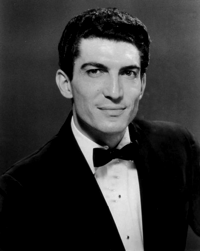Marco Delvecchio - footballer
Striker who became TV dance show star
The former Roma and Italy striker Marco Delvecchio, who launched a new career in television after finishing runner-up in the Italian equivalent of Strictly Come Dancing, was born on this day in 1973 in Milan. Delvecchio scored 83 goals in exactly 300 appearances for Roma, where he was part of the side that won the Scudetto in 2000-01 and where he became a huge favourite with fans of the giallorossi because of his penchant for scoring against city rivals Lazio. His record of nine goals in the Rome derby between 2002 and 2009 was the best by any player in the club’s history until that mark was overtaken by the Roma great Francesco Totti, whose career tally against Lazio was 11. Delvecchio’s talents were somewhat underappreciated at international level. He made 22 appearances for the azzurri and the first of his four goals was in the final of Euro 2000 against France, although he finished on the losing side. Yet after being favoured by Dino Zoff, he was not so popular with Zoff’s successor as head coach, Giovanni Trapattoni, who took him to the 2002 World Cup but did not give him a game, and omitted him from his squad for the 2004 Euros. Read more…
__________________________________________________________________
Domenico Dragonetti - musician
Venetian was best double bass player in Europe
The composer and musician Domenico Dragonetti - Europe's finest double bass virtuoso - was born on this day in 1763 in Venice. Apart from the fame his talent brought him, Dragonetti is remembered as the musician who opened the eyes of Ludwig van Beethoven and other composers to the potential of the double bass. They met in Vienna in 1799 and experts believe it was Dragonetti’s influence that led Beethoven to include passages for double bass in his Fifth Symphony. From 1794 onwards until his death in 1846 at the age of 83, Dragonetti lived in London but it was in Venice that he established his reputation. The son of a barber who was also a musician, Domenico Carlo Maria Dragonetti taught himself to play the guitar and the double bass as a child using his father’s instruments. It was not long before word of his precocious ability spread and he was sent to the Ducal Palace of San Marco for tuition from Michele Berini, who was widely respected as the best double bass player in Venice. Berini declared after only 11 lessons that there was nothing more he could teach the young Dragonetti. Read more…
_________________________________________________________________
Giovanni Battista Rubini - opera singer
Tenor was as famous in his day as Caruso
Giovanni Battista Rubini, born on this day in 1794, was a tenor as famous in his day as Enrico Caruso would be almost a century later, his voice having contributed to the popularity of opera composers Vincenzo Bellini and Gaetano Donizetti. He was the first 19th-century non-castrati singer to become a major international star after two centuries in which audiences and composers were obsessed with the castrati. Rubini's exceptionally high voice could match the coloratura of the castrati and he effectively launched the era of the bel canto tenor, which signalled the end of the dominance of the castrati. Rubini was just 12 when he was taken on as a violinist and chorister at the Riccardi Theatre in Bergamo, not far from his home town of Romano di Lombardia. He was 20 when he made his professional debut in Pietro Generali’s Le lagrime d’una vedova at Pavia in 1814, then sang for 10 years in Naples in the smaller, comic opera houses. Famed for a voice capable of reaching beyond the range of conventional tenors, particularly in the higher registers, in 1825 he sang the leading roles in Gioachino Rossini’s La Cenerentola, Otello, and La donna del lago in Paris. Read more…
Home



























